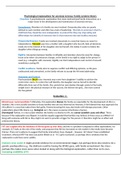Psychological explanations for anorexia nervosa: Family systems theory
Overview: A psychodynamic explanation that views dysfunctional family interactions as a
major factor in the development and maintenance of anorexia nervosa.
Enmeshment: Members of a family are over involved. Overprotective roles are poorly
defined to each member and often has a lack of leadership. This links to anorexia in that if a
child feels they should be more independent, to protest this they may stop eating and
differentiate her identify of everyone else (in that everyone else eats healthy amounts)
Overprotectiveness: Family are involved obsessively in a way that leaves no room for
independence. Palozzoli says how a mother with a daughter who has AN, feels all decisions
made are in the interest of her daughter and not herself, this makes it easier to blame the
daughter when things go wrong.
Rigidity: interaction between families is inflexible and members deny the need for change.
Issues arise when circumstances change, as the family is too rigid to adapt to the person in
need (e.g. a daughter with anorexia). Rigidity can limit independence and control of oneself,
sometimes causing AN.
Conflict avoidance: Family aims to suppress conflict and differing opinions, so AN goes
undiscussed and unresolved, as the family refuses to accept the AN need addressing
Autonomy and Control:
Psychoanalysts Bruch says: Anorexia may come from daughters’ inability to achieve the
control she craves. To control her self-identity, the daughter starves herself to identify
differently from rest of the family. She controls her own destiny through control of her body,
weight loss is the physical measure of this success, the thinner she gets… the more control
she has gained.
Evaluation +/-
Ethical issue/ social sensitivity? Ultimately, this explanation blames the family as responsible for the development of AN in a
member, this is very socially sensitive to those families who are less informed on Anorexia, if felt blamed they may approach the
AN sufferer in a way that makes them feel guilty. Parents knowing this may also hinder with therapy processes. Other
explanations place little blame e.g., biological see’s the causes as passive inheritance of genes.
(Developed) Further, it is not certain whether the family is to blame for AN, we cannot establish cause and effect. This is
because if the explanation was flipped, it could be equally suggested that families may behave in these ways as a RESULT of
living with someone with AN as they might not want to provide a trigger for the person. It therefore might be an effect and
criticises the theory.
FST can’t explain why the incidence of AN has gone up over time; and this is a problem compared to other explanations, for
example, SLT looks at the role of the media, and proposes that AN has increased as role models in the media have become
thinner. There isn’t evidence to suggest that family interactions have changed – however, SLT doesn’t have established
treatment, whereas BFST has been successful (Robin et al. 9/11 girls recovered), so perhaps this is evidence that the
explanation could have some validity.
Diathesis stress model: it might provide evidence for an environmental trigger, but perhaps there also needs to be a
genetic predisposition e.g., the diathesis could be having the EPHX2 gene, with family enmeshment the stress –
perhaps this makes more sense when looked at along with the biological explanation, rather than on its own,
increasing credibility of FS






